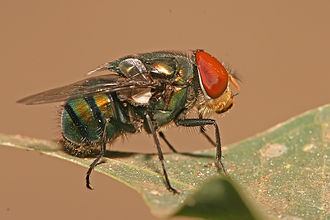Calliphoridae

The Calliphoridae (commonly known as blow flies, blow-flies, carrion flies, bluebottles, greenbottles, or cluster flies)[4] are a family of insects in the order Diptera, with 1,200 known species. The maggot larvae, often used as fishing bait, are known as gentles.[5] The family is known to be polyphyletic, but much remains disputed regarding proper treatment of the constituent taxa,[6] some of which are occasionally accorded family status (e.g., Bengaliidae and Helicoboscidae).[7]
The name blow fly comes from an older English term for meat that had eggs laid on it, which was said to be fly blown. The first known association of the term “blow” with flies appears in the plays of William Shakespeare: Love’s Labour’s Lost, The Tempest, and Antony and Cleopatra.[8][9][4][10]
Calliphoridae adults are commonly shiny with metallic colouring, often with blue, green, or black thoraces and abdomens. Antennae are three-segmented and aristate. The aristae are plumose their entire length, and the second antennal segment is distinctly grooved. Members of Calliphoridae have branched Rs 2 veins, frontal sutures are present, and calypters are well developed.
The characteristics and arrangements of hairlike bristles are used to tell the difference between members of this family. All blow flies have bristles located on the meron. Having two notopleural bristles and a hindmost posthumeral bristle located lateral to presutural bristle are characteristics to look for when identifying this family.
The thorax has the continuous dorsal suture across the middle, along with well-defined posterior calli. The postscutellum is absent or weakly developed. The costa is unbroken and the subcosta is apparent on the insect.[11][12][13]
Most species of blow flies studied thus far are anautogenous; a female requires a substantial amount of protein to develop mature eggs within her ovaries (about 800 µg per pair of ovaries in Phormia regina). The current theory is that females visit carrion both for protein and egg laying, but this remains to be proven. Blow fly eggs, usually yellowish or white in color, are about 1.5 mm × 0.4 mm, and when laid, look like rice grains. While the female blow fly typically lays 150–200 eggs per batch, she is usually iteroparous, laying around 2,000 eggs during the course of her life. The sex ratio of blow fly eggs is usually 50:50, but one exception is females from two species of the genus Chrysomya (C. rufifacies and C. albiceps), which are either arrhenogenic (laying only male offspring) or thelygenic (laying only female offspring).
Hatching from an egg to the first larval stage takes about 8 hours to a day. Larvae have three stages of development (instars); each stage is separated by a molting event. The instars are separable by examining the posterior spiracles, or openings to the breathing system.[14] The larvae use proteolytic enzymes in their excreta (as well as mechanical grinding by mouth hooks) to break down proteins on the livestock or corpse on which they are feeding. Blow flies are poikilothermic – the rate at which they grow and develop is highly dependent on temperature and species. Under room temperature (about 20 °C), the black blow fly Phormia regina can change from egg to pupa in 150–266 hours (six to 11 days). When the third larval stage is complete, it leaves the corpse and burrows into the ground to pupate, emerging as an adult 7-14 days later.
